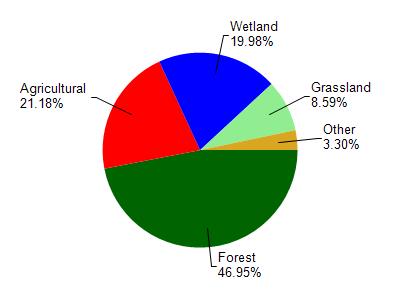Waushara
No
Yes
No
Fish and Aquatic Life
Overview
Lucerne Lake (Egans), in the White River Watershed, is a 41.57 acre lake that falls in Waushara County. This lake is an outstanding/exceptional resource water under NR102 under the Fisheries Program. This lake is managed for fishing and swimming and is currently not considered impaired.
Date 2011
Author Aquatic Biologist
Historical Description
Source: 1970, Surface Water Resources of Waushara County Lucerne (Egans) Lake T-18-N, R-11-E, Sections 20, 21 Surface Acres = 4.9; S.L.F. = 1.20; Maximum Depth = 34 feet.
A moderate sized, landlocked seepage lake located in the Town of Marion. The lake basin is slightly irregular and the shoreline is characterized by steep slopes. The shallow water zones are quite restrictive around the lake. A small border shelf surrounds the lake before the drop-off . The primary water source is from seepage and small springs. The bottom materials in the littoral zone consists primarily of sand and mud. The lake develops an upper thermocline at 20 feet during midsummer. The fishery of the lake includes largemouth bass, bluegill, perch, sunfish, and walleye. In an attempt to introduce walleye, a plant of 4,500 fingerling fish was made in 1963. During a shocker survey in the fall of 1965, only 16 walleyes from this planting, ranging in length between 12.0-14.9 inches, were sampled. The lake is known locally for good bluegill fishing in the spring of the year. The surrounding habitat supports nesting for mallards and bluewing teal, and the lake is used during the spring and fall migrations by mallards and bluewing teal. Long term water level fluctuations are the only major problem evident. There is one private camp and one boat livery on the lake sponsored by the Evangelical United Brethern Church, which owns practically all of the adjacent shoreline. Public access with an improved boat landing and parking is available on the west shore.
Date 1970
Author Surface Water Inventory Of Wisconsin
General Condition
Lucerne Lake (Egans) (104600) was assessed during the 2016 listing cycle; total phosphorus sample data were clearly below 2016 WisCALM listing thresholds for the Recreation use and Fish and Aquatic Life use. This water was also assessed for chlorides and sample data were clearly below 2016 WisCALM chronic and acute listing criteria for the Fish and Aquatic Life use. This water is meeting these designated uses and is not considered impaired.
Date 2015
Author Ashley Beranek
Condition
Wisconsin has over 84,000 miles of streams, 15,000 lakes and milllions of acres of wetlands. Assessing the condition of this vast amount of water is challenging. The state's water monitoring program uses a media-based, cross-program approach to analyze water condition. An updated monitoring strategy (2015-2020) is now available. Compliance with Clean Water Act fishable, swimmable standards are located in the Executive Summary of Water Condition in 2018. See also the 'monitoring and projects' tab.
Reports
Management Goals
Wisconsin's Water Quality Standards provide qualitative and quantitative goals for waters that are protective of Fishable, Swimmable conditions [Learn more]. Waters that do not meet water quality standards are considered impaired and restoration actions are planned and carried out until the water is once again fishable and swimmable
Management goals can include creation or implementation of a Total Maximum Daily Load analysis, a Nine Key Element Plan, or other restoration work, education and outreach and more. If specific recommendations exist for this water, they will be displayed below online.
Monitoring
Monitoring the condition of a river, stream, or lake includes gathering physical, chemical, biological, and habitat data. Comprehensive studies often gather all these parameters in great detail, while lighter assessment events will involve sampling physical, chemical and biological data such as macroinvertebrates. Aquatic macroinvertebrates and fish communities integrate watershed or catchment condition, providing great insight into overall ecosystem health. Chemical and habitat parameters tell researchers more about human induced problems including contaminated runoff, point source dischargers, or habitat issues that foster or limit the potential of aquatic communities to thrive in a given area. Wisconsin's Water Monitoring Strategy was recenty updated.
Grants and Management Projects
| Project Name (Click for Details) | Year Started |
|---|
|
|
Monitoring Projects
| WBIC | Official Waterbody Name | Station ID | Station Name | Earliest Fieldwork Date | Latest Fieldwork Date | View Station | View Data |
|---|
| 104600 | Lake Lucerne | 703029 | Lucerne Lake - Deepest Point | 2/24/1981 | 1/1/2015 | Map | Data |
| 104600 | Lake Lucerne | 10007401 | Lake Lucerne | 7/27/1999 | 6/15/2020 | Map | Data |
| 104600 | Lake Lucerne | 10018792 | Lake Lucerne -- Access | 9/30/1963 | 6/15/2020 | Map | Data |
|

Watershed Characteristics
Lake Lucerne is located in the White River watershed which is 149.81 mi². Land use in the watershed is primarily forest (47%), agricultural (21.20%) and a mix of wetland (20%) and other uses (11.90%). This watershed has 156.65 stream miles, 1,017.38 lake acres and 18,495.17 wetland acres.
Nonpoint Source Characteristics
This watershed is ranked Not Ranked for runoff impacts on streams, Not Ranked for runoff impacts on lakes and High for runoff impacts on groundwater and therefore has an overall rank of High. This value can be used in ranking the watershed or individual waterbodies for grant funding under state and county programs.However, all waters are affected by diffuse pollutant sources regardless of initial water quality. Applications for specific runoff projects under state or county grant programs may be pursued. For more information, go to surface water program grants.